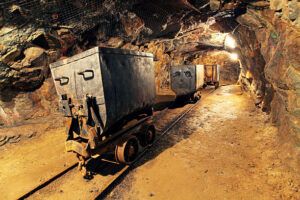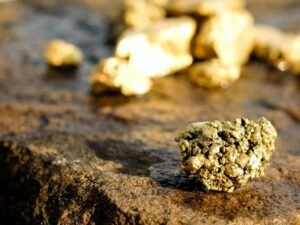The gold mining history in North America was first documented at the Reed farm in North Carolina in 1799. This gold discovery did not create much excitement however, it was the first commercial production of gold.
Since then, various discoveries have been made in different states and has continuously occurred over the years since it was first discovered. Below we have listed the states in the US that are most interesting when it comes to gold mining both historically and in the present time. Keep reading to learn about the history of gold mining!
California

California gold was discovered by James W. Marshall, a carpenter, in 1848. While working on a water-powered sawmill, he found flakes of gold along the American River at the base of the Sierra Nevada Mountains near Coloma, California. This discovery triggered the biggest gold rush in the history of gold mining in America. It is deemed the period when large-scale production of gold in America began.
Hard rock mining, also known as quartz mining in California, first began in 1849 before hydraulic mining was introduced in 1852. With the massive migration of people into California, the state’s population increased tremendously, reaching thousands. This, in turn, significantly increased the gold production up to 121 tonnes (3.9 million troy ounces) only in 1852 when gold production peaked. However, with the increased mining levels, production dropped drastically in 1865, up to only 867,000 troy ounces.
Production was boosted up to 1.4 million troy ounces when prices of gold were increased between the years 1939 to 1941. In 1943, the federal government ordered the closure of all gold mines to free resources for the war, which led to a drop in gold production again, dropping up to 148,000 troy ounces. After the war, gold production has never reached the early 1940s peak since fixed prices and inflation eroded the value of gold.
Arizona
Arizona has produced more than 498 tons of gold. Mining in this state began around 1774 when a Spanish priest Manuel Lopez directed Papago Indians to wash gold from gravel on the sides of the Quijotoa Mountains. It continued until 1849 when the California gold rush attracted the miners. In 1863, gold was discovered at the Vulture Mine in Maricopa County. This gold mine produced 11,400 kgs of gold up to 1959. The gold mine at Oatman was the last to operate in Arizona back in 1998.
Virginia
Gold mining was also recorded in Virginia in 1804 by placer mining, then soon after by lode mining until the California gold rush started and most miners moved.
Colorado
In Colorado gold was first discovered in minimal deposits in 1858 during the Pike’s Peak Gold rush in present-day Denver. A substantial discovery was then made in Idaho Springs in 1859. Only the Cripple Creek and Victor Gold mines currently produce gold. In 2018, the two mines produced 11,000 kilograms of gold.
Nevada
This is the leading gold-producing state in America, producing 78% of America’s gold and 5% of the world’s gold. A lot of the gold comes from open-pit mining. Between 1835 and 2017, Nevada had produced 205,931,000 troy ounces of gold. Some of the active gold mines within the state are those at Carlin Trend and Jerrit Canyon.
Gold mining at Carlin was first discovered in the 1870s in small quantities. Placer deposits were then found in 1907 but still in small amounts. The Carlin mine began producing large-scale gold in 1965 and has since been the largest gold-producing district.
North Carolina

This is reported to be the first gold rush in the history of American gold mining. The rush came about when a 12-year-old boy Conrad Reed discovered a large nugget of gold while playing at his family farm at Meadow Creek in 1799. Not knowing the value of what he had found, the boy took the nugget to his father, who then hung it as a doorstop for many years until 1802. Later he showed it to a jeweler who identified it as gold and offered to buy it.
Upon discovering the value of what his son had found, the dad entered into a partnership with three other men in an endeavor to find more nuggets. In 1803 they found a gold nugget weighing 13kgs. Since the properties were individually owned upon the discovery, most farmers began searching for gold on their farms through placer mining. By 1825 the placer deposits had been exhausted, and the first lode mine shaft was excavated. Approximately 1.2 million troy ounces of gold were produced from over fifteen districts.
New Mexico
Placer mining in New Mexico was first reported in the 1600s along the Northern Rio Grande. More significant deposits were, however, found in 1828 along the Ortiz mountains. This discovery was then later followed by a discovery of more significant lode deposits. After that, more deposits were found at the Rattlesnake vein in 1877 and Wicks gulches. The settlement of whites in New Mexico in 1848 created the biggest gold rush in New Mexico. Although gold deposits have been discovered along most Mexican rivers, most of the gold production comes as a by-product of other minerals mining activities. New Mexico has been unable to produce large deposits of gold due to the lack of water owing to its dry climate.
Montana
Gold was first discovered in 1852, but mining didn’t start till 1862 when gold placers were discovered at Bannack. More placers were discovered at Virginia city, Helena, and butte in 1863 and 1864. Mining still actively continues in the Golden Sunlight mines and the Montana Tunnels.
The Black Hills and Lead, South Dakota
Gold was first discovered by two gold miners who were part of Lieutenant Colonel George Armstrong’s force in the Black Hills in 1874. Hark Harney, Alex Engh, Moses, and Fred Manuel discovered gold near Lead in South Dakota. Homestake was the name they gave to their claim, and the mine was named after it. The Homestake mine was the longest surviving mine in the United States before closing its doors. The Homestake mine is 8,000 feet deep, with 375 miles of tunnels being North America’s deepest mine. The mine has produced gold supply for the country close to 10 percent.
I hope this article was helpful and that you found it interesting. If you have any questions, we will be more than happy to answer them below.
All the best,
Pete

Very interesting and informative article on the history of gold mining!
I really enjoyed reading this!
Thank you!
Happy to learn you enjoyed this article, appreciate you taking the time to let us know.
Wishing you a great day!
/Pete